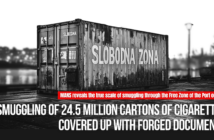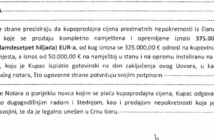The Water Administration of Montenegro has had information since 2014 that works on the regulation of the Morača River endanger the water source Bolje sestre, from which the Regional Waterworks is supplied. However, the works on the regulation were suspended only in December 2020, which means that the main water source for Montenegrin coastline was endangered for six years.
This is clearly shown by the minutes from the meeting held at the Water Administration on November 13, 2014, when it was stated that the restrictions from the Environmental Impact Assessment Study of the works on regulating the flow of the Morača River, which refer to the allowed elevation of the trough bottom, were breached. Bearing in mind the importance of this issue, as well as the evident pointing out to it in the previous ten years, it remains unclear why the regulation of Morača was stopped only in December last year.
2011 Environmental Impact Assessment Study on regulating the flow of the Morača River from the Sitnica mouth near Botun to Ponar states: ”In order to provide even more adequate protection, the position of the Water Administration is to limit all excavations to elevation at 10 meters above sea level. This elevation was determined as a reference based on the conclusion of the Expert Team for reviewing and proposing appropriate measures in order to protect the Bolje sestre source, formed by the Water Administration in 2009. Namely, the position of the Team is that any excavations must not be carried out below the stated elevation, in order to protect the clay layer under the layers of gravel and sand, and this project has complied with that.”
From the Meeting Minutes held in the Water Administration in the fall of 2014, into which Kombinat had an insight, it can be seen that the Administration knew that these restrictions from the Study had been largely breached. At the meeting, which was attended by several representatives of the Water Administration, Regional Waterworks, the Administration for Inspection Affairs and the relevant ministry, representatives of the supervision of the works presented geodetic recordings of the current situation showing elevations from 3.84 to 7.54 meters above sea level, which was far below the limit of 10 m above sea level provided by the study. On the other hand, the supervision claimed that the elevation of the bottom of Morača never exceeded the height of 3.84 to 7.54 meters, and that the elevation of 10 m above sea level refers to the area upstream.
The Center for Investigative Journalism of Montenegro (CIN CG) announced in March this year that Bolje sestre are on the wane. Namely, in September last year, a record minimum abundance of source of 334 l/s was measured. For comparison’s sake, in 2005, the water source had an abundance of 2,660 l/s. This situation threatens to endanger the water supply of the Montenegrin coast during the summer tourist season.
Cause: (non)human factor
Since 2011, the companies “Cijevna komerc”, “Beton Montenegro” and “Bemax” have been regulating the flow of the Morača river, all according to the project and on the basis of a contract with the Water Administration. In addition to the flow regulation itself, the project envisages “removal of excess material”. The material is in fact sand and gravel, which the companies engaged in the project bought at a price of about 2.8 euros per cubic meter. The price of this material on the market, after being processed, ranges from 8 to 15 euros per cubic meter.
“During the implementation of the goals, it should be taken care not to disturb the natural regimes of groundwater and surface water, especially from the aspect of protection of the “Bolje sestre” source, which is determined as the main water source for the Regional Water Supply of Montenegrin coast” – 2009 Main Project for the Regulation of the Morača River reads. This project is being implemented by the Water Administration with the aim of “defence against floods of banks and facilities, and regulation of the Morača riverbed regarding sediment transport”.
Part of the flow covered by the project was divided into four sections, the first was regulated by “Cijevna Komerc”, the second by “Beton Montenegro”, the third by “Bemax”, while the 4th section was not taken over by the contractors. In addition to these works, the condition of the Morača riverbed has also been affected by people who, individually or in groups, illegally extract material from the river, despite the 2017 moratorium.
In June this year, PCNEN reporters visited the separation processes a dozen times at different times of day, and were convinced that the machines were working at night, and that trucks full of sand were leaving the sites at around seven in the morning. For more than a month, the Administration for Inspection Affairs, whose water management inspection is competent to conduct misdemeanour and criminal prosecution of illegal devastators, has not answered PCNEN’s questions regarding this issue.
Morača river is located less than 2 km as the crow flies from the source Bolje sestre. The change in the characteristics of the river bed, indirectly and through groundwater, affects the abundance of the source. Awareness of this problem apparently existed at the time of drafting the flow regulation project. However, it took almost a decade to point out the trend of declining abundance of the Bolje sestre source, which has been noted all these years, for the Water Administration temporarily suspend regulation works in December after the devastating results of measurements performed in September last year.
The problem has been pointed out for years
Since 2010, the Regional Waterworks (RW), which manages the source and delivers water to towns at the coastline, has been pointing to the problem, primarily of illegal exploitation of gravel and sand from Morača river, but also of the potential impact of regulation works.
Former director of RW, Goran Jevrić, told Kombinat that in the past ten years, the company sent over 150 letters to institutions regarding the exploitation of sand and gravel from Morača and the dangers that these activities bring to the source.
“At the request of the line minister, Mr. Ratko Mitrović, we submitted a list of letters that we sent to the competent authorities on this issue. Those are, first of all, the Ministry of Agriculture, Water Management and Forestry, the Water Administration, the Ministry of Sustainable Development and Tourism. We also addressed the Administration for Inspection Affairs, with which we signed the Protocol on Cooperation in 2014, with the primary goal of controlling the exploitation of sand and gravel, and in 2015 we even wrote to the State Prosecutor’s Office. In addition, we addressed the National Parks, the Communal Police of the Capital City, the Protector of Property and Legal Interests and others, in short, all competent institutions.”
RW also warned about the potentially harmful effects of the works on the regulation of Morača at the meetings with the representatives of the Water Administration in 2014, Ivan Špadijer, technical director of the Regional Waterworks, stated.
When the commissioning of Karuč source was abandoned in 2005, and was turned to the Bolje sestre source due to better geological conditions, thanks to which Montenegrin coastline is properly supplied today, no one could have imagined the drastic changes in the abundance of this source
Bolje sestre water source is located in the area of Malo Blato on Skadar Lake, and since 2010, this source has been supplying the entire Montenegrin coastline with water, which until then had been facing salinization and water shortages during the summer.
The abundance of the source in 2005 was 2,660 litres per second, which is significantly more than the projected needs even for 2045. After five years of research, the International Association of Hydrogeologists has included the Bolje sestre on the UNESCO map of the 150 most important karst springs in the world.
All this was not enough for the Water Administration to recognize the importance of this source and to stop the works on the Morača riverbed in time, although they were aware that they could be the cause of a drastic drop in the abundance of the source.
Scientifically proven impact of the regulation
On June 14, at the Bolje sestre water source, a presentation of the results of the research on the impact of the exploitation of sand and gravel from Morača on the water source was held by experts from Belgrade’s “Energoprojekt”, hired by the RW. The research proved that the undoubted reason for the decline in the abundance of the Bolje sestre water source is precisely the change in the Morača’s riverbed, caused by the extraction of sand and gravel.
The presentation was also attended by the Minister of Ecology, Spatial Planning and Urbanism, Ratko Mitrović, who stated that this problem is not new and that it should have been dealt with much earlier. “This problem did not occur yesterday, this problem has been happening continuously for the last 15 years. We are now in a situation to put out the fire. This research should have been done much earlier in order to be able to take precautionary measures”, Mitrović said.
The results of the research showed that, if the problem is not addressed in time in the form of a declining trend in water abundance of the source, which from a minimum abundance of 1,600 to 2,100 l/s in the period from 2010 to 2013 reached the level of 334 l/s in September last year, it is clear that the expected needs of RW will not be met in the future. According to the “worst case scenario”, this would mean that the Montenegrin coastline would be left without an adequate water supply in the period of the year when it is most needed – during the summer tourist season, it was said at the presentation.
The recommendation of “Energoprojekt” is to immediately stop any exploitation of sand and gravel from Morača, to record in detail its condition in the endangered zone and take measures to rehabilitate the riverbed, consider technical solutions to return the river to its natural state, as well as to make a regulation project regarding the current situation, which will take into account the above recommendations.
The research concludes that if all activities that affect the Morača riverbed and thus the water source were stopped, the minimum abundance would be 750 to 800 l/s. However, due to the already changed Morača riverbed and the acceleration of its flow, it now naturally moves the gravel deposits, which can lead to a worsening of the state. This must be prevented by riverbed remediation activities.
On the other hand, Damir Gutić, director of the Water Administration and a member of the Bosniak Party of Montenegro, who also attended the presentation of the results of the research on Bolje sestre last month, still does not believe that the impact of exploitation from Morača on the water source has been proven.
When asked why it took so long for the works to stop, Gutić told Kombinat, “Well, no evidence has been submitted yet that there is a direct connection between Morača river and the Bolje sestre water source. As soon as we were given any indications that there was a possibility, we stopped the works.”







